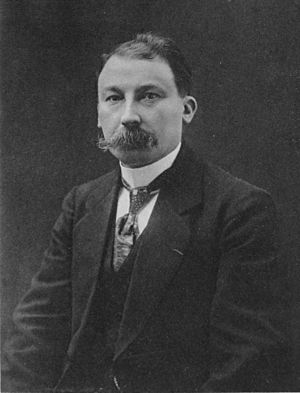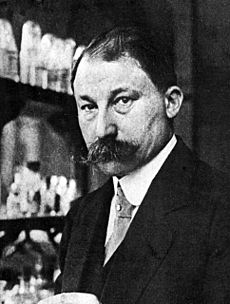Victor Grignard facts for kids
Quick facts for kids
Victor Grignard
|
|
|---|---|

Grignard in 1912
|
|
| Born | 6 May 1871 Cherbourg, France
|
| Died | December 13, 1935 (aged 64) Lyon, France
|
| Resting place | Guillotière Cemetery, Lyon |
| Alma mater | University of Lyon |
| Known for | Grignard reaction Grignard reagent |
| Spouse(s) | Augustine Marie Boulant |
| Children | Roger Grignard |
| Awards | Nobel Prize for Chemistry (1912) Lavoisier Medal (1912) |
| Scientific career | |
| Fields | Organic chemistry |
| Institutions | University of Nancy |
| Doctoral advisor | Philippe Barbier |
Francois Auguste Victor Grignard (born May 6, 1871 – died December 13, 1935) was a French chemist. He won the Nobel Prize because he discovered something very important. He found the Grignard reagent and the Grignard reaction. These are special chemical tools and processes. They are super useful for building new chemical molecules, especially by connecting carbon–carbon bonds.
Contents
Victor Grignard's Life Story
Victor Grignard was born in France. His father was a sail maker. People described Victor as a humble and friendly person.
He first tried to study mathematics. But he didn't pass his entrance exams. In 1892, he joined the army for one year. After his army service, he went back to study math. He earned his degree from the University of Lyon in 1894.
Starting Chemistry Research
Later that year, Victor switched to chemistry. He started working with Professors Philippe Barbier and Louis Bouveault. At first, he wasn't very interested in the topics he was studying. So, he asked Professor Barbier for a new research idea.
Professor Barbier suggested he look into a chemical reaction. This reaction usually didn't work well with zinc. But it worked a little better when using magnesium. They wanted to make alcohols from other chemicals.
Victor thought that certain chemicals (aldehydes and ketones) were stopping the magnesium from reacting properly. This explained why they got so little product.
A Big Discovery: The Grignard Reagent
Victor tested his idea. He first added a chemical called an alkyl halide with magnesium to a special liquid. Then, he added the aldehyde or ketone. This simple change made a huge difference! They got a lot more of the desired product.
A few years later, Victor was able to find the special chemical that formed in the middle of this reaction. He heated magnesium with another chemical and added a dry liquid. A reaction happened, and he got a new product. This product is now known as the Grignard reagent.
The Grignard reagent is a special compound containing magnesium. It reacts easily with other chemicals. This helps create alcohols with very high yields (meaning you get a lot of the alcohol you want). Victor discovered this important chemical reaction, now called the Grignard reaction, in 1900.
Teaching and Winning the Nobel Prize
In 1901, Victor Grignard finished his important research paper. He became a lecturer in organic chemistry in 1909. Then, in 1910, he became a full professor at the University of Nancy.
In 1912, Victor Grignard and another chemist, Paul Sabatier, won the Nobel Prize in Chemistry. This was a huge honor for their amazing discoveries!
Work During World War I
During World War I, Victor Grignard helped his country. He studied special chemicals used in war. He worked on making a chemical called phosgene. He also found a way to detect mustard gas. In 1918, he discovered that sodium iodide could be used to test for mustard gas on the battlefield. This test was very sensitive and worked well.
Victor Grignard passed away on December 13, 1935, in Lyon. He was 64 years old.
What is the Grignard Reaction?
Victor Grignard is most famous for creating a new way to connect carbon atoms together. This is very useful for making new chemicals in a lab. The Grignard reaction happens in two main steps:
- Step 1: Making the Grignard Reagent
- First, you make the "Grignard reagent." This is a special chemical compound that contains magnesium. You make it by reacting a chemical called an organohalide with magnesium metal. The Grignard reagent is often written as R-Mg-X.
- Step 2: Adding the Carbonyl
- Next, you add a chemical called a carbonyl (like a ketone or an aldehyde) to the Grignard reagent. The carbon atom from the Grignard reagent connects to the carbon atom in the carbonyl. The oxygen atom from the carbonyl then attaches to the magnesium.
- After this, you add a weak acid to the mixture. This helps to create an alcohol, which is the final product. The magnesium salts are then removed.
Military Service and Honors
Victor Grignard first joined the French military in 1892. He became a corporal. After two years, he left the army to continue his studies.
In 1912, after winning the Nobel Prize, he received a special medal called the Legion of Honour. He was made a Chevalier (a knight).
When World War I started, Victor was called back to the military. He was still a corporal. At first, he was on guard duty. But then, the army leaders noticed his Legion of Honour medal. They realized he was a Nobel Prize winner! They decided he would be much more useful doing research. So, they assigned him to the explosives division.
Later, Victor's research changed to finding ways to protect against chemical weapons. Eventually, he was asked to research new chemical weapons for the French army.
Honors and Awards
- 1912: Nobel Prize in Chemistry (shared with Paul Sabatier)
- 1912: Lavoisier Medal from the French Chemical Society
- 1933: Commander of the Légion d'Honneur
See also
In Spanish: Victor Grignard para niños


